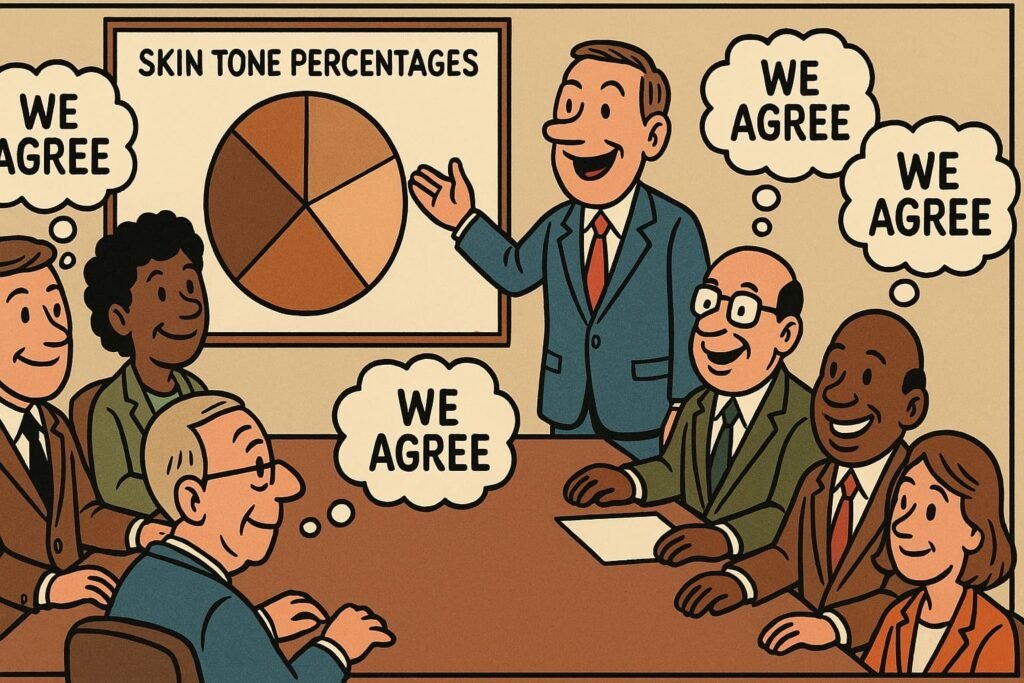Diversity – Counting Heads, Not Ideas
Every company, university, and government office brags about it. “We’re committed to diversity.” The posters show smiling faces of every shade, gender, and ability. But scratch the surface and you’ll find the same grey sameness: identical policies, identical language, identical thinking.
Because “diversity” today isn’t about ideas. It’s about counting heads.
Table of contents
Buzzword Breakdown
- Diversity → Sounds like variety, means counting skin tones in a spreadsheet.
- Representation → A marketing metric, not an achievement.
- Targets / Quotas → HR’s version of Five-Year Plans.
What Diversity Used to Mean
In normal English, “diversity” simply meant variety. A mix of perspectives, experiences, and ways of thinking. A diverse workplace used to mean you’d hear different stories, learn from colleagues with unusual backgrounds, maybe spark creative clashes of ideas.
That kind of diversity happens naturally in an open society. You don’t need bureaucrats to enforce it.
What It Means Now
Today, “diversity” has been stripped down to the most superficial checklist:
- Skin colour.
- Gender identity.
- Sexual orientation.
HR no longer asks, “What do you bring to the table?” Instead it’s, “Which demographic box can we tick for you?”
The result? Hiring for optics. Promotion for optics. Entire departments dedicated to publishing glossy reports to impress shareholders.
It’s not diversity. It’s accounting.
It is Business
Diversity isn’t free. It’s an industry.
- HR managers run endless workshops on “unconscious bias.”
- Consultants sell expensive “diversity audits.”
- Universities churn out graduates fluent in the language of quotas.
- Corporations release annual reports full of pie charts showing “representation targets.”
Meanwhile, the actual business — making products, serving customers, innovating — takes a back seat to demographic theatre.
The Irony
The great irony is that in chasing “diversity,” institutions end up stamping out the only kind that really matters: diversity of thought.
Walk into a “diverse” office today and you’ll find employees of every colour nodding along to the exact same script. Challenge it, and you’re accused of “not being inclusive.”
So the faces are varied, but the minds are cloned.
Why It Matters
- Tokenism breeds resentment. Nobody likes being hired as a statistic.
- Real struggles are ignored. Class, wages, and universal rights take a back seat to identity quotas.
- Conformity wins. “Diversity” becomes a camouflage for sameness.
It was supposed to broaden the conversation. Instead, it narrowed it to what you look like and who you sleep with.
Conclusion
The tragedy of “diversity” is that it started with a good idea: variety makes us stronger. But in the hands of HR, activists, and politicians, it became another hollow buzzword.
We ended up with endless faces on posters, identical words in mouths, and fewer fresh ideas than ever.
Real diversity — of thought, debate, and values — is what got cancelled.
👉 For the full picture of how Diversity, Equity, and Inclusion really work, visit our DEI Explainer Hub.
FAQ
What’s the difference between diversity and inclusion?
It is about who’s in the room. Inclusion is about making rules for how they speak once they’re there.
Isn’t diversity just fairness?
Fairness is equal opportunity. Today, it is engineered outcomes. Not the same thing.
Who decides what counts as diversity?
Usually HR managers and activists with a spreadsheet, not the employees themselves.
How do universities push diversity quotas?
By setting demographic targets in admissions. See: Universities – The Factory of Woke Graduates.
Who profits from diversity programs?
Consultants, NGOs, and HR departments. See: NGOs & Activism – The Business of Selling Justice.



